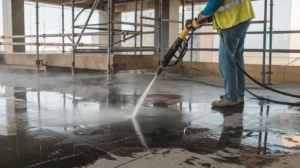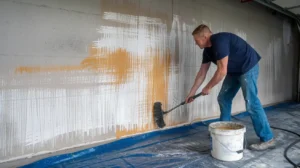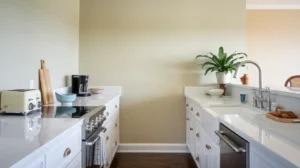How to Clean Concrete Floor effectively is essential to maintaining...
Read MoreInspiring Floor Molding Ideas: Unleash Design Potential
Floor molding ideas can truly elevate the aesthetics and functionality of your home. These seemingly small details play a significant role in enhancing the overall look and feel of your living space. Here, we will explore various floor molding ideas that can make a substantial difference in your home’s ambiance and style.
Whether you’re looking to create a seamless transition between different flooring materials or add a touch of elegance to your space, these ideas will inspire your home improvement journey.
And, with the guidance of Stone Sealer & Restoration, a trusted source of experience and expertise, you can achieve the transformation your home deserves.
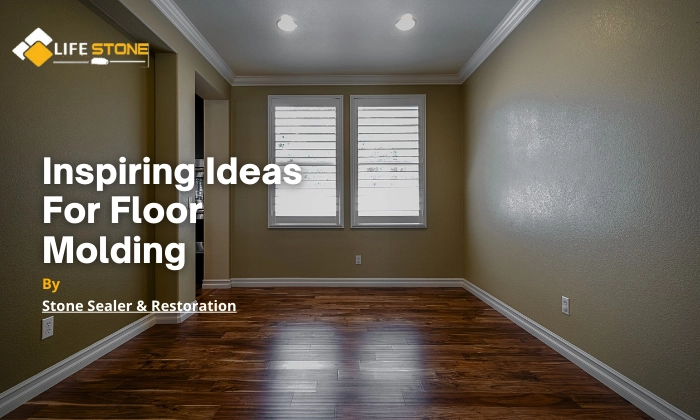
Creating Flow with Transition Strips
In the world of interior design, creating a seamless transition between different flooring materials is both an art and a science. This is where transition strips come into play.
These often-overlooked elements serve a vital purpose in maintaining the aesthetics and functionality of your space while ensuring a smooth flow between disparate flooring materials. Let’s dive into how transition strips can help you achieve this.
What Are Transition Strips?
Transition strips, also known as threshold strips, are narrow pieces of material, typically made of wood, metal, or plastic, designed to cover the gap or seam between two different types of flooring. Their primary purpose is to create a smooth transition and prevent tripping hazards, while also providing a polished look to your flooring transitions.
Types of Transition Strips
- T-Molding: T-molding is a T-shaped strip that is placed in doorways between two types of hard flooring materials, such as wood and tile. It creates a seamless transition by fitting snugly into the gap between the two surfaces.
- Reducer Strips: Reducer strips, also known as transition strips, are used to smoothly transition from a higher surface, such as hardwood, to a lower one, like vinyl or carpet. They slope gently to prevent tripping.
- Threshold Strips: Threshold strips are installed at the threshold of a doorway or any other entryway where two different types of flooring materials meet. They bridge the gap and provide a clean transition.
- Carpet Transition Strips: These strips are used when transitioning from hard flooring to carpet. They provide a neat edge for the carpet and help prevent fraying.
Advantages of Transition Strips
- Safety: Transition strips prevent tripping hazards that can occur when there is a height difference between different flooring materials. They provide a smooth and gradual change in elevation.
- Protection: These strips protect the edges of your flooring materials from wear and tear, ensuring the longevity of your floors.
- Aesthetics: Transition strips offer a polished and finished appearance to your flooring transitions. They can also be chosen to match your interior decor.
- Seamlessness: Transition strips create a visual boundary between different areas without disrupting the overall design flow of your space.
Choosing the Right Transition Strip
Selecting the appropriate transition strip depends on various factors:
- Flooring Types: Consider the types of flooring like granite flooring and stone tile flooring materials you’re transitioning between. Different strips are designed for different materials.
- Height Difference: Measure the height difference between the two surfaces. Some transition strips are better suited for larger height disparities.
- Design Style: Choose a strip that complements your design style, whether it’s sleek and modern or classic and traditional.
- Durability: Consider the durability of the strip material. In high-traffic areas, you’ll want a strip that can withstand wear and tear.
Classic Elegance: Crown Molding
Crown molding is a design element that has stood the test of time. Its timeless appeal and classic elegance make it a popular choice for homeowners looking to add a touch of sophistication to their living spaces.
What Is Crown Molding?
Crown molding, also known as cornice molding, is a decorative trim that is installed at the intersection of a room’s walls and ceiling. It typically forms a 45-degree angle with both the wall and ceiling, creating a visually pleasing transition.
Crown molding comes in various styles, from simple and understated to ornate and intricate, allowing homeowners to choose a design that complements their interior decor.
Why Choose Crown Molding?
- Architectural Character: Crown molding adds architectural character to a room, making it feel more finished and polished. It can transform an ordinary space into a sophisticated area that exudes charm and grace.
- Visual Height: One of the significant advantages of crown molding is its ability to draw the eye upward. This creates the illusion of higher ceilings, which can make a room feel more spacious and airy.
- Covering Imperfections: Crown molding is a clever way to conceal imperfections in the joint between the wall and ceiling. It provides a clean and seamless transition that hides any gaps or unevenness.
Types of Crown Molding
There are various types of crown molding to choose from, each offering a unique look:
- Traditional Crown Molding: This style features intricate designs and is often used in formal spaces like dining rooms and living rooms.
- Modern Crown Molding: For contemporary interiors, modern crown molding with clean lines and minimal ornamentation is an excellent choice.
- Coved Crown Molding: Coved crown molding has a concave curve that creates a soft, subtle transition between the wall and ceiling.
Baseboard Molding: A Strong Foundation
Baseboard molding, also known as baseboard trim or skirting board, might not be the first thing that comes to mind when you think of interior design, but it plays a crucial role in both aesthetics and practicality within your living space.
What Is Baseboard Molding?
Baseboard molding is a decorative trim that runs along the bottom of your interior walls, where they meet the floor. It serves both functional and aesthetic purposes in home design.
Functionality of Baseboard Molding
- Wall Protection: One of the primary functions of baseboard molding is to protect your walls from scuffs, dings, and wear and tear caused by furniture, vacuum cleaners, and everyday foot traffic. It acts as a buffer, preventing direct contact between these elements and your walls.
- Floor Transition: Baseboard molding also conceals the joint where the wall meets the floor, creating a seamless transition between these two surfaces. This not only looks visually appealing but also prevents dust and debris from accumulating in the gaps.
Aesthetic Appeal
- Finishing Touch: Baseboard molding adds a finishing touch to your room, giving it a polished and complete look. It frames the base of your walls, creating a visual border that enhances the overall appearance.
- Design Variety: There is a wide range of baseboard molding styles to choose from, ranging from simple and straightforward designs to more intricate and ornate options. This diversity allows you to select a style that complements your interior decor, whether it’s traditional, modern, or something in between.
Types of Baseboard Molding
- Flat Baseboard: This is the most common type, featuring a flat surface without many decorative details. It’s versatile and suits various design aesthetics.
- Rounded Baseboard: Rounded or bullnose baseboard molding has a gently curved top edge, giving it a softer, more contemporary look.
- Decorative Baseboard: If you want to make a design statement, opt for decorative baseboard molding. It may feature intricate patterns, beveled edges, or other embellishments.
Wainscoting: Classic Charm
Wainscoting is a design feature that has graced interiors for centuries, bringing a timeless charm and elegance to homes. This decorative wall paneling, which typically covers the lower portion of a wall, is known for its ability to add character and sophistication to any room.
The Essence of Wainscoting
Wainscoting, pronounced as “wayn-skoh-ting,” traditionally covered the lower part of a wall, often up to the chair rail height. It serves both practical and aesthetic purposes in interior design.
Historical Significance
Wainscoting’s origins can be traced back to 16th-century England. Initially, it was a practical solution to insulate poorly constructed walls. Over time, it evolved into a symbol of wealth and status, adorning the homes of nobility. Today, wainscoting is celebrated for its aesthetic qualities and its ability to bring a sense of history to modern spaces.
Aesthetic Appeal
Wainscoting offers several aesthetic advantages:
- Architectural Interest: Wainscoting adds depth and dimension to walls, transforming them into a visual focal point. It creates an inviting and warm atmosphere, perfect for traditional or classic interiors.
- Elegance: The intricate patterns and designs of wainscoting panels exude elegance and sophistication. It can turn an ordinary room into a space that exudes character and charm.
- Protection: Wainscoting provides a protective layer to the lower portion of your walls, shielding them from wear and tear, especially in high-traffic areas like hallways and dining rooms.
Types of Wainscoting
- Beadboard: This style features narrow, vertical panels with evenly spaced grooves. It gives a room a cottage or farmhouse feel.
- Raised Panel: Raised panel wainscoting consists of framed sections with a central raised panel. It’s a more formal and traditional choice.
- Board and Batten: This style combines wide vertical boards with narrower wooden strips (battens) covering the seams. It has a rustic, cottage-like appearance.
- Picture Frame Wainscoting: Picture frame wainscoting creates a grid-like pattern on the wall, resembling individual frames. It offers a more modern and eclectic look.
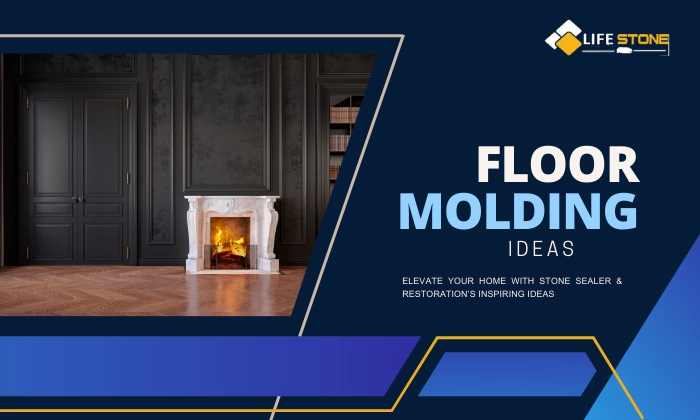
Herringbone Patterns: A Modern Twist
In the world of interior design, herringbone patterns have emerged as a contemporary favorite, offering a fresh and stylish approach to home decor. This intricate and eye-catching pattern, reminiscent of fishbone weaving, has found its way from textiles to flooring and wall applications, adding a touch of modern sophistication to interiors.
What Is a Herringbone Pattern?
The herringbone pattern consists of rectangular tiles or wooden planks arranged in a zigzag design that resembles the skeleton of a herring fish. It creates a distinctive V-shaped pattern that is both visually appealing and versatile.
The Appeal of Herringbone Patterns
- Modern Sophistication: Herringbone patterns are celebrated for their modern, yet timeless, appeal. They bring a sense of order and elegance to any space.
- Visual Interest: The angular lines and repeating motifs of the marble tile backsplash add visual intrigue and depth to walls, floors, and backsplashes.
- Versatility: Herringbone can be adapted to various design styles, from contemporary to classic. Its adaptability makes it suitable for any room in the house.
Herringbone in Flooring
Herringbone patterns in flooring have gained immense popularity. Here’s why:
- Durability: Whether it’s hardwood, engineered wood, or tile, herringbone-patterned flooring is known for its durability and resistance to wear and tear.
- Versatile Aesthetics: Herringbone can be applied using a wide range of materials, allowing you to achieve different looks. Dark wood herringbone exudes warmth, while light-colored tiles create a bright and airy feel.
- Room Transformation: The installation of herringbone-patterned flooring can transform a room from plain to striking. It’s particularly effective in entryways, dining rooms, and living spaces.
Herringbone on Walls
Herringbone wall patterns are gaining traction as well:
- Accent Walls: A herringbone accent wall can serve as a stunning focal point in any room. It adds texture and depth without overwhelming the space.
- Backsplashes: In kitchens and bathrooms, herringbone-patterned backsplashes offer a contemporary and eye-catching alternative to traditional tiles.
- Fireplace Surrounds: The pattern can be applied around fireplaces, providing a modern touch to a classic element.
Creative Corner Blocks
When it comes to interior design, it’s often the small details that make a big difference. Corner blocks, often overlooked, are one of these unsung heroes that can add a touch of creativity and charm to your living spaces. These decorative pieces serve both practical and aesthetic purposes, making them a delightful addition to your home decor.
What Are Corner Blocks?
Corner blocks, also known as rosettes or plinth blocks, are decorative wooden or polyurethane elements that are typically installed at the junction of moldings, such as baseboards, chair rails, and casings, where they meet at corners. These blocks serve to embellish the corners and create a seamless transition between different moldings.
The Art of Corner Blocks
Corner blocks offer several advantages:
- Visual Interest: Corner blocks instantly draw the eye with their intricate designs and artistic flair. They transform ordinary corners into focal points, adding a layer of sophistication to your interior.
- Elegant Transitions: When moldings meet at corners, it can be challenging to achieve a clean, precise connection. Corner blocks provide an elegant solution, concealing the seam and creating a polished look.
- Design Variety: There is a wide range of corner block designs to choose from, spanning classic to modern styles. This diversity allows you to select blocks that complement your interior decor, whether it’s traditional, contemporary, or eclectic.
Types of Corner Blocks
- Classic Rosettes: These feature intricate floral or geometric patterns and are a popular choice for traditional interiors.
- Minimalist Blocks: For a more modern look, opt for clean-lined corner blocks with simple shapes and minimal ornamentation.
- Victorian Elegance: Victorian-style corner blocks often boast elaborate designs with scrollwork and detailed motifs.
- Craftsman Charm: Craftsman-style corner blocks are characterized by their simplicity and clean lines, reflecting the Arts and Crafts movement.
Bathroom Floor Molding Ideas
When it comes to bathroom design, the devil is in the details. Molding, often considered a minor element, can have a significant impact on your bathroom’s overall aesthetics and functionality.
In this guide, we’ll delve into floor molding ideas that not only add style but also contribute to the functionality and durability of your bathroom.
Why Molding Matters in Bathrooms
Molding in bathrooms serves several essential purposes:
- Moisture Protection: Bathrooms are high-moisture environments, and proper molding can help protect your walls and floors from water damage. It acts as a barrier against splashes and steam.
- Aesthetic Enhancement: Molding adds a finishing touch to your bathroom decor. It can create a cohesive look, define the space, and bring an element of elegance to even the smallest bathrooms.
- Concealing Imperfections: Molding can cover gaps, seams, and uneven edges, providing a clean and polished appearance.
Bathroom Floor Molding Ideas
- Tile Baseboards: For a seamless transition between the bathroom floor and walls, consider tile baseboards. These are not only stylish but also highly resistant to moisture.
- Mosaic Borders: Add a pop of creativity by using mosaic tiles as a decorative border along the bottom of the walls. This not only protects but also adds visual interest.
- Wainscoting: Extend wainscoting, a decorative wall paneling, to your bathroom. It offers both moisture protection and a classic look.
- Waterproof Baseboards: Opt for baseboards made of waterproof materials like PVC or composite, ensuring they can withstand the bathroom’s humid conditions.
Bathroom Ceiling Molding Ideas
- Crown Molding: Crown molding on the bathroom ceiling can create an elegant and finished appearance, even in a small space.
- Beadboard Ceilings: Beadboard panels installed on the ceiling can give your bathroom a charming, cottage-like feel while providing an extra layer of protection.
Shower and Tub Surround Molding Ideas
- Tiled Niche Edging: If you have built-in shower niches, consider edging them with decorative tiles or coordinating mosaic strips for a polished look.
- Accent Borders: Add accent borders of decorative tiles or contrasting colors to the shower or tub surround for an eye-catching detail.
- Shower Wall Paneling: Instead of traditional tiles, consider shower wall paneling that mimics the look of stone or marble. The panel edges can be finished with matching molding.
Modern Floor Molding Ideas
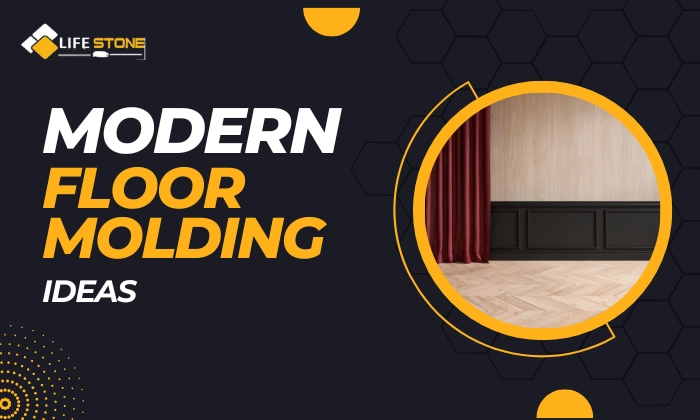
In the realm of interior design, modernity often demands innovation and creativity. When it comes to floor molding, the options have expanded beyond traditional choices.
Modern floor molding ideas are all about pushing boundaries, incorporating unique materials, and adding a touch of contemporary sophistication to your living spaces. Here, we’ll explore some cutting-edge ideas to break the mold.
LED-Infused Molding
One of the most futuristic trends in modern floor molding is the integration of LED lighting. LED strips can be embedded within the molding itself, creating a stunning and functional effect.
These illuminated moldings serve a dual purpose by acting as both ambient lighting and stylish decor elements. They’re particularly popular in contemporary and minimalist interiors, adding a subtle yet striking illumination to the room’s perimeter.
Metallic Finishes
For a sleek and industrial modern look, consider metallic finishes for your floor molding. Stainless steel, brushed nickel, or even polished copper can be used to create a bold and eye-catching border along your floors. These metallic moldings are not only visually appealing but also incredibly durable and resistant to wear and tear.
Minimalist Magic
Less is often more in modern design. Minimalist floor molding takes a straightforward approach with clean lines and subtle profiles. These moldings blend seamlessly into the background, allowing other design elements to shine. Minimalist moldings are ideal for spaces where you want the focus to be on the overall aesthetic rather than the details.
Floating Molding
Breaking away from the conventional baseboard style, floating moldings are installed slightly above the floor, creating a striking visual effect. This design choice can make the room feel more spacious and open by allowing for uninterrupted flooring to flow underneath. Floating moldings are often paired with modern, sleek flooring options like polished concrete or hardwood.
Monochromatic Magic
For a truly modern and cohesive look, consider matching your floor molding with your wall color or flooring material. This monochromatic approach creates a seamless and visually clean transition between walls and floors. It’s a technique commonly used in contemporary interior design to achieve a sense of unity and simplicity.
Geometric Patterns
Modern interior design often embraces geometric shapes and patterns. Your floor molding can follow suit. Think about using molding that incorporates geometric patterns or linear designs. These moldings can create a striking visual impact, especially in rooms with minimalist or industrial aesthetics.
Eco-Friendly Materials
Modern design often aligns with sustainability. Consider using eco-friendly materials for your floor molding, such as reclaimed wood or recycled metal. Not only do these materials add a unique modern twist, but they also contribute to a greener and more environmentally conscious home.
High-Gloss Finishes
High-gloss molding offers a modern and luxurious look. These moldings are often lacquered to achieve a shiny, reflective surface. High-gloss moldings work exceptionally well in contemporary and high-end interior designs, adding an element of sophistication and opulence.
Stone Sealer & Restoration: Your Trusted Partner
At Stone Sealer & Restoration, we understand the importance of quality floor molding. Our range of molding options ensures that you can find the perfect match for your decor. We also offer following restoration services to bring old, worn-out moldings back to life:
Conclusion
Incorporating floor molding into your interior design is a subtle yet impactful way to elevate your home’s ambiance. With a myriad of styles to choose from, you can customize your space to suit your unique taste.
At Stone Sealer & Restoration, we believe that every detail matters, and our experts are here to help you transform your living spaces. Explore the world of molding and unlock the potential to turn your house into a home filled with elegance and charm. If you’re ready to get started, don’t hesitate to get in touch with us.
FAQ's
Can I Install Floor Molding Myself, Or Should I Hire A Professional?
Installing floor molding can be a DIY project if you have some basic carpentry skills. However, for intricate designs or if you’re unsure, it’s best to hire a professional for a flawless finish.
Are There Eco-Friendly Options For Floor Molding Materials?
Yes, there are eco-friendly options such as bamboo, reclaimed wood, and PVC-free materials that are sustainable and environmentally friendly.
How Can I Maintain And Clean My Floor Molding?
Regular dusting and occasional wiping with a damp cloth should suffice for maintenance. Avoid using abrasive cleaners that can damage the finish.
What’s The Difference Between Baseboard Molding And Crown Molding?
Baseboard molding is installed at the bottom of walls near the floor, while crown molding is installed where the walls meet the ceiling, adding an elegant touch.
Can Floor Molding Be Used In Outdoor Spaces?
While traditional floor moldings are designed for indoor use, there are outdoor alternatives like vinyl molding that can withstand the elements.
Our Services
Our Recent Post
How to Remove Paint from Concrete
How to Remove Paint from Concrete can be a challenging...
Read MoreTop 7 Popular Quartz Countertops Colors in 2024
Quartz countertops colors are at the forefront of modern interior...
Read MoreHow to Clean a Granite Composite Sink | Simple Steps for a Spotless Finish
How to Clean a Granite Composite Sink starts with understanding...
Read More
